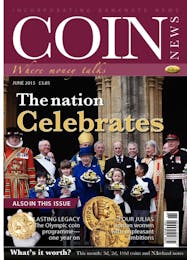A matter of note
THE recent announcement by the Bank of England (BofE) that Sir Winston Churchill is to appear on a future banknote (probably the £5 in 2015/16, but that may change) has been greeted with the predictable responses from the predictable quarters. There are those who are praising the choice of “Winnie”—after all he is one of the most recognisable of Britons—but inevitably there are others who are bemoaning the decision. A certain faction with political motivation is stating that the choice of a second Tory Prime Minister to grace a BofE note (the Duke of Wellington appeared on the series D £5) is both monstrously unfair and plain wrong, especially in today’s political environment, as the two men gained fame/notoriety (pun intended) defeating a European enemy . . . aren’t we all friends now . . .? Others are complaining that the only woman to be portrayed on a banknote, Elizabeth Fry on the current £5, is to be replaced by yet another man, why not a woman? This argument holds some weight (unlike the political one which just seems to be point scoring for the sake of it), however, a list of names given by the public to the BofE for possible inclusion on future notes shows few women and fewer of those are as well known as Churchill. I can certainly see Jane Austen or Elizabeth Browning, Grace Darling or one of the Bronte sisters turning up in our wallets and purses in the future, but others, such as Elizabeth Garret Anderson or Octavia Hill, might have the public scratching their heads in bemusement. The simple fact is that the “Great Britons” we would like to see featured on our coins and notes are more likely to be men than women, that’s because in order to be considered truly great the chances are you would have to have done something pretty remarkable and also have been dead for a while—the nature of our society up until the late 1800s meant that it was less likely women would be in a position to do something “remarkable” (at least something recognised by everybody) and so the pool to choose from is inevitably smaller. As time passes the number of women who fall into the category of “likely to be on a banknote” will grow, although with the recent furore over her death and funeral I don’t see Baroness Thatcher turning up on a tenner any time soon! Of course, as one of the (female) members of the Token Team pointed out: every single BofE note has a woman on it so people really shouldn’t be complaining about sexism!
The choice of Churchill is intriguing though—not least because he becomes one of the few who can be seen on a coin and a note. Every coin collector in the country (and beyond) is familiar with the Churchill Crown (no sorry, they really aren’t worth that much) and with this new note he will join Darwin and Dickens as the only three men to be seen on both forms of currency in England (Darwin appeared on the 2009 £2, 200 years after his birth and Dickens was similarly honoured in 2012, 200 years after his birth. Both men appeared on the £10 note, Dickens on the Series E, Darwin currently). Florence Nightingale, of course, also appeared on a £10 and the 100th anniversary of her death in 1910 was also commemorated on a £2 coin, but only her name, not her image was shown. And no, the £2 coin with the steam locomotive was celebrating Trevithick and not Stephenson’s Rocket so the Series E £5 doesn’t count, although I do accept there was a £25 gold proof coin depicting the Rocket struck in 2004—but that isn’t going to be widely seen so I don’t think that counts either. However, for me the real reason Churchill’s depiction is of interest is from a design point of view. I remember when Charles Darwin was chosen for the £10 note and Sir Edward Elgar’s face was seen on the £20, the BofE told us then that one of the reasons they had been chosen was because of their wonderful beard and moustache respectively, more hair being better for banknote design as it was an added anti-counterfeit measure. Well, in case no-one has noticed, Churchill didn’t have much of a beard or moustache, in fact the last time I looked at a picture of him he wasn’t very hirsute at all! I will be very interested to see what security measure the new note has to make up for the distinct lack of hair on the new subject!

Archives
-
2024 (7 articles)
-
2023 (35 articles)
-
2022 (19 articles)
-
2021 (31 articles)
-
2020 (45 articles)
-
2019 (26 articles)
-
2018 (28 articles)
-
2017 (25 articles)
-
2016 (23 articles)
-
2015 (21 articles)
-
2014 (30 articles)
-
2013 (31 articles)
-
2012 (44 articles)
-
2011 (36 articles)
-
2010 (50 articles)
-
2009 (38 articles)
-
2008 (47 articles)
-
2007 (34 articles)
-
2006 (31 articles)
-
2005 (12 articles)
-
2004 (6 articles)
-
2003 (11 articles)
-
2002 (5 articles)
-
2001 (5 articles)









